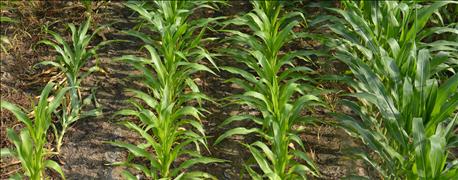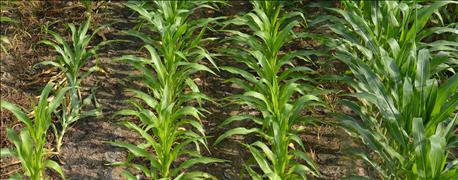
You could make the case that soil compaction has been one of the biggest yet most ignored factors preventing corn yields from going higher over the past four decades. You won’t get any argument from Gary Steinhardt. He is the Purdue University Extension agronomist who helped bring the perils of soil compaction to light in the early 1980s.
Corn Illustrated 10/31: Lessons learned in the growing season of 2016

COMPACTION OR N DEFICIENCY? These plants are deficient in nitrogen. However, the root cause may be that soil compaction set up saturated soils for denitrification and loss of nitrogen.
“There is absolutely no doubt that once created, soil compaction can interfere with plant growth in various ways,” he says. “The problem is that there isn’t just one symptom of soil compaction. It can show up in various forms. Sometimes it may not show up at all, and then show up again the following year if weather conditions are different.”
For example, suppose a crop scout determines that corn plants are showing signs of nitrogen deficiency. Perhaps they are yellow. Or perhaps some plants are showing the classic symptoms of browning starting at the tip and running down the midrib back toward the plant. The scout reports that the problem in the field is a lack of nitrogen.
“The real cause might trace back to soil compaction,” Steinhardt explains. “Perhaps you applied enough nitrogen, but soils stayed saturated after application due to soil compaction. That resulted in denitrification and nitrogen loss. In some cases, plant roots may also struggle to move through compacted layers to get to nitrogen that remains in the soil. Either way, it will show up as a nitrogen deficiency in the plant.”
Something similar can happen with potassium, Steinhardt notes. Suppose plants are showing browning along leaf margins. It’s the classic symptom of potassium deficiency in a corn plant. The crop scout records signs of the deficiency and recommends applying potassium through fertilizer.
The plants truly are short on potassium, Steinhardt says. But in this case, it could be because the roots can’t get to the potassium due to soil compaction.
Good scouting technique
“We thought we had this problem solved many years ago when we noticed that plants were often short on potassium in compacted plots,” Steinhardt explains. “We thought all we needed to do was add potash in the 2-inch-by-2-inch starter. We did that, and guess what? It didn’t help at all.”
Steinhardt advises anyone going out to scout fields, including students he works with, to keep in mind that there is always the potential that soil compaction could be involved in whatever situation they observe. A penetrometer can come in handy to check for deep compaction. Most penetrometers are calibrated so the dial shows a higher reading or goes into a red zone when it is tough to push the rod through the soil due to compacted layers.
Corn Illustrated 10/24: Corn with significant ear rot needs special storage
A scout may also want to carry a small shovel or trowel when checking for shallower soil compaction. Examining plant roots can reveal a lot, Steinhardt adds. If roots are showing signs of a nutrient deficiency but growing sideways, along plates in the soil, the real problem may be soil compaction, not a lack of nutrients.
About the Author(s)
You May Also Like




